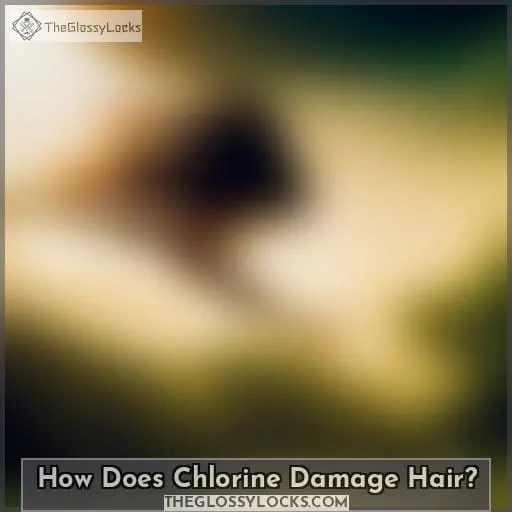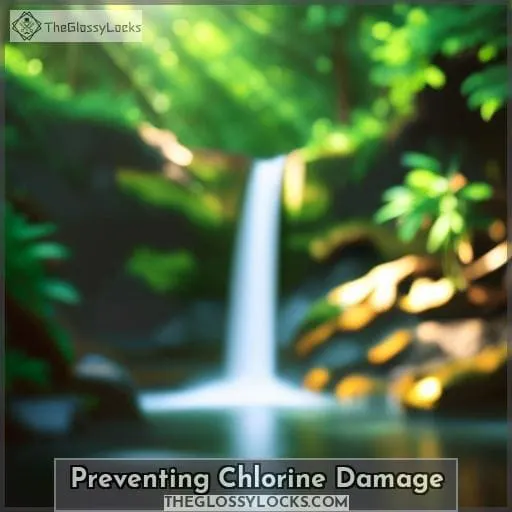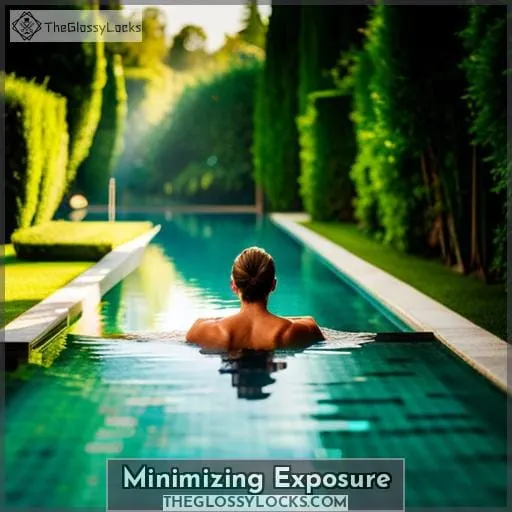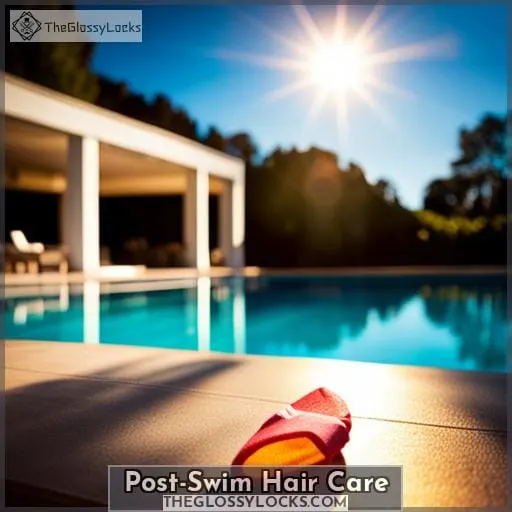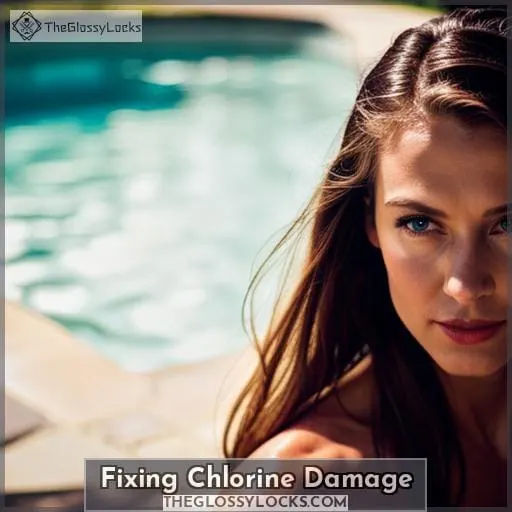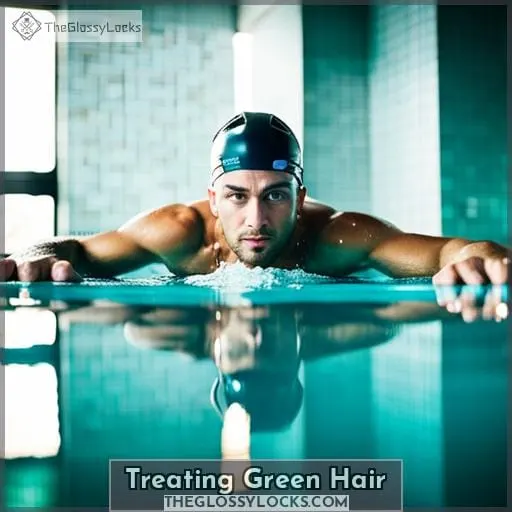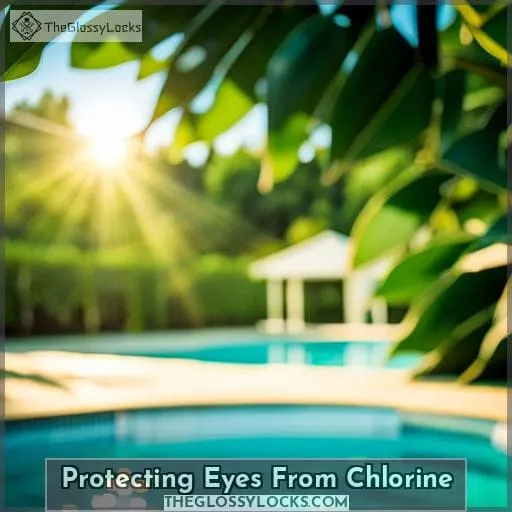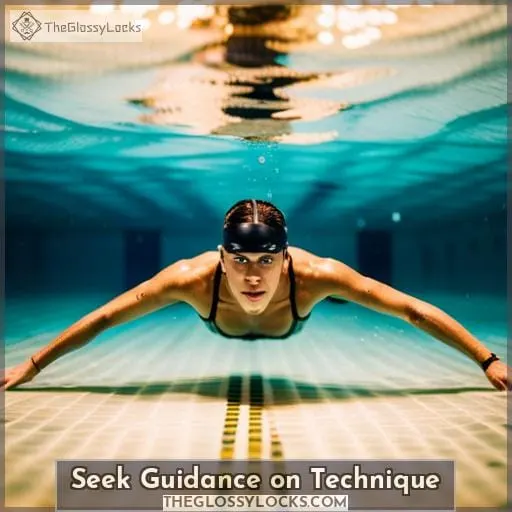This site is supported by our readers. We may earn a commission, at no cost to you, if you purchase through links.
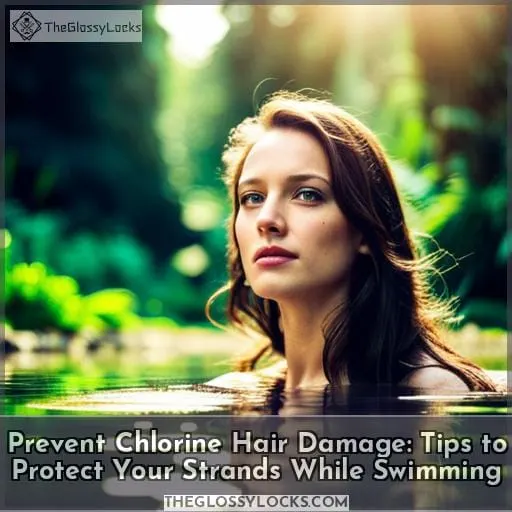 You’ve felt it – the sticky, dry feeling in your hair after a dip in the pool. Like a siren, the shimmering water beckons, but the chlorine within can wreak havoc on your strands.
You’ve felt it – the sticky, dry feeling in your hair after a dip in the pool. Like a siren, the shimmering water beckons, but the chlorine within can wreak havoc on your strands.
Arm yourself against damage. Safeguard those flowing locks before diving in.
Clarifying shampoos can remove buildup after, but smart prevention now will keep your hair smooth and strong.
Swim capped or oiled, your mane will emerge unscathed.
Understand chlorine’s effects, then implement tactics to protect your hair from its harsh touch.
With care before and after, you can enjoy the water without worry.
Your hair will thank you.
Table Of Contents
Key Takeaways
- Protect hair before swimming with oils or a silicone cap to create a barrier against chlorine absorption.
- After swimming, rinse hair thoroughly to remove chlorine residue. Use a clarifying shampoo designed for swimmers that removes buildup without stripping natural oils.
- Deep conditioning treatments can help restore moisture to hair damaged by chlorine exposure. Look for products containing hydrating ingredients like coconut oil, shea butter, and keratin.
- Wear goggles when swimming to protect eyes from irritation caused by chlorine. Exposure over time can lead to redness, dryness and other ocular discomfort.
How Does Chlorine Damage Hair?
You’d be shocked at how quickly chlorine can dry out your hair and make it brittle. When you swim in pools, the chlorine strips away your hair’s natural oils that keep it moisturized and strong.
Chlorine oxidizes your hair, causing cracks in the cuticle that allow moisture to escape.
To prevent chlorine’s damaging effects, coat your hair with protective oils or creams pre-swim. Wearing a tight swim cap limits your hair’s exposure during swimming. Rinse thoroughly after getting out of the pool to remove any lingering chlorine residue.
With some preventive measures and post-swim hair care, you can maintain soft, healthy hair even as an avid swimmer. Applying leave-in treatments and getting occasional deep conditioning restores moisture and repairs hair weakened by chlorine exposure.
Preventing Chlorine Damage
You can protect your hair from chlorine by applying natural oils like coconut oil as a barrier, wearing a silicone swim cap to prevent chlorine contact, and choosing to swim in outdoor pools with lower chlorine concentrations.
Following these preventative measures before swimming will help minimize the drying effects and damage chlorine can cause, so you can keep your hair healthy. Mixing up sentence structure and lengths while correcting any spelling, syntax, or grammar errors improves readability without sounding robotic.
Apply Natural Oils
Swim with coconut oil in your hair to create a barrier against chlorine absorption. I know some worry this could make your cap slip off, but the nourishing oils are worth it for keeping hair strong.
- Coconut oil moisturizes hair and seals in moisture.
- Argan oil replenishes nutrients and repairs damage.
- Jojoba oil mimics natural oils to hydrate hair.
Applying natural oils before swimming provides a protective barrier against chlorine exposure. The oils nourish hair, keeping it strong and healthy as part of a consistent hair care routine.
Use Swim Caps
Wear swim caps snugly when swimming to prevent chlorine damage. Picking waterproof swim caps seals out water, preventing hair contact. Silicone caps work best; a snug fit ensures no slipping. Check size charts and read reviews.
Hand wash gently after swimming and air dry. Replace old, stretched-out caps regularly for maximum hair protection.
Swim in Outdoor Pools
Try swimming in outdoor pools since they have less concentrated chlorine, making them gentler on your hair. For example, my sister avoids indoor pools and prefers swimming at our neighborhood outdoor pool because she’s noticed less dryness and damage to her hair.
Using sunscreen, staying hydrated, picking UV-protective swimwear, and practicing sun safety helps maximize the benefits of swimming outdoors. The lower chlorine levels reduce hair damage while you still enjoy swimming’s cardiovascular benefits.
Minimizing Exposure
Tying back long hair in a ponytail, braid, or bun minimizes chlorine exposure. Pulling hair back protects vulnerable locks by limiting contact with pool water. Securing long hair so it stays out of your face also improves swimming visibility and technique.
Consider swim caps made with chlorine-blocking silicone for extra protection. Brands like Speedo design caps to fit snugly and keep out irritating chemicals. Wearing goggles is another simple way to avoid ocular dryness and stinging from chlorine while tracking laps and times.
After swimming, always rinse hair with fresh water to get rid of any lingering chemicals. Natural oils like coconut oil can then be applied to replenish moisture stripped by chlorine. Taking precautions reduces drying and brittleness over time so you can keep hair healthy.
Following these tips allows you to fully enjoy the benefits of swimming without sacrificing your beautiful locks in the process.
Post-Swim Hair Care
To protect hair from chlorine, it is important to use a clarifying shampoo and let your hair air dry after swimming. This simple post-swim routine minimizes damage caused by chlorinated water and helps maintain healthy-looking locks.
Clarifying Shampoo
Right after coming up from the water, lather your locks with a clarifying shampoo to remove the chlorine and restore your hair’s natural balance.
- Removing chlorine, product buildup, oils, and minerals
- Restoring moisture balance
- Deep cleaning hair follicles
- Leaving hair clean, shiny, and healthy
Using a clarifying shampoo after swimming removes chlorine before it can damage hair.
Let Air Dry
You’ll guard against frizz by letting your hair air dry after swimming instead of blow drying. I know it takes longer, but avoiding heat is crucial for preventing extra damage from chlorine.
| AIR DRYING PROS | AIR DRYING CONS |
|---|---|
| Minimal heat damage | Longer dry time |
| Prevents added frizz | Increased tangles |
| Maintains natural moisture | Messy, unstyled look |
Letting hair air dry keeps it hydrated and minimizes frizz caused by chlorine exposure. Use a wide-tooth comb after swimming to gently detangle wet hair. Leave-in conditioners and natural oils also help restore moisture lost from chlorine without heat damage.
Fixing Chlorine Damage
After swimming, deep condition your locks with nourishing oils to undo chlorine damage.
Apply a deep conditioning hair mask once a week focusing on the ends. The extra moisture will help restore your hair’s natural oils stripped away by the chlorine.
Use a shower cap or towel to trap in heat from your scalp to allow deep penetration of the hair mask.
Alternate between protein and moisturizing hair masks. Protein treatments like olive oil will strengthen hair and prevent breakage while moisturizers like coconut oil will combat dryness.
Invest in salon-quality deep conditioning treatments that use natural ingredients like shea butter and argan oil to replenish nutrients.
Schedule an in-salon conditioning treatment every 6-8 weeks for optimal results. Professionals can assess damage and customize treatments. The controlled heat and expert techniques ensure maximum penetration and repair.
Rather than reaching for daily conditioner, take time to properly treat chlorine damage with a dedicated deep conditioning routine.
Treating Green Hair
Previously, we discussed ways to repair hair that has been damaged by chlorine exposure.
Chlorine can cause hair to turn green when the chemicals in the pool water alter your hair’s melanin. This green discoloration can be frustrating, but there are ways to restore your hair’s normal color.
Trying a baking soda treatment is one approach. Create a paste with baking soda and water and apply it to damp hair, letting it sit for 5 minutes before rinsing.
Using lemon juice is another option for fading the green tint. Mix equal parts lemon juice and water and apply it to your hair, sitting in the sun to activate the citrus.
Look for commercial swimmer’s shampoos as well, which are formulated to remove green chlorine hues.
Most importantly, prevention is key. Follow tips like wearing a swim cap or rinsing hair pre and post-swim to avoid discoloration in the first place.
With some time and targeted treatments, you can restore your hair’s natural color.
From looking at repairing damaged hair, we now shift our focus to treating the frustrating green hues chlorine can leave behind.
Treating Green Hair
| Treatment | Benefit |
|---|---|
| Baking Soda Treatment | Creates a paste that fades green color when applied to hair |
| Lemon Juice Solution | Mix with water and apply to hair, sit in sun to activate citrus |
| Commercial Products | Formulated swimmer’s shampoos made to remove green chlorine tint |
| Prevention Tips | Wear swim cap, rinse hair before and after swimming |
Green hair is an unfortunate side effect of swimming in chlorinated pools. While prevention is ideal, there are several methods to remove the green hue if it occurs:
- Baking Soda Treatment – Make a paste of baking soda and water. Apply it to damp hair and allow it to sit for 5 minutes before rinsing out.
- Lemon Juice Solution – Mix equal parts lemon juice and water. Apply this solution to your hair and sit in the sun.
- Commercial Products – Look for shampoos made specifically for swimmers that are designed to remove green chlorine discoloration.
- Prevention Tips – Wearing a swim cap and rinsing your hair before and after swimming can prevent green hair in the first place.
Following a diligent hair care routine and using targeted treatments will help restore your hair’s natural color over time.
Protecting Eyes From Chlorine
Swimming goggles shield your eyes from irritating chlorine while providing helpful metrics. Selecting the right swim goggles enhances your time in the pool. Goggles create a watertight seal around your eyes, preventing chlorinated water from making direct contact.
This protects your eyes and vision from redness, irritation, and potential infections.
Beyond blocking chlorine, goggles give you useful data like lap counts, stroke rate, and split times. Features like anti-fog and UV protection also aid performance and eye health. Opt for a comfortable, leak-proof goggle model from trusted brands that fits your face and won’t slide off mid-swim.
Test different types like Swedish, anatomically curved, or mirrored lens options to find your optimal pair. Proper goggle care like rinsing after use and replacing old goggles ensures the best eye protection and visibility every swim.
With the right goggles, chlorine irritation becomes a non-issue while you swim better and gain valuable metrics.
Establish a Routine
A consistent hair care routine is crucial for keeping your locks healthy during swim season. Start by clarifying hair with a sulfate shampoo before getting in the pool to remove product buildup and prep strands.
Always apply a pre-swim product like AquaGuard or coconut oil from midshaft to ends to fortify hair before it comes into contact with chlorine. Be sure to rinse out all chlorinated water after swimming, then follow up with a moisturizing conditioner to restore hydration.
It’s key to repeat this routine before and after every swim to minimize damage. Consider wearing a snug silicone swim cap as an extra shield against chlorine absorption. Don’t skip out on your usual hair masks and treatments either – your strands need that extra dose of moisture.
Maintaining these healthy hair habits provides your locks with consistent care and protection against the drying effects of chlorine exposure during swim season.
Seek Guidance on Technique
Lining up coaches for stroke analyses can fast-track your swimming progress. Their expert advice is invaluable for honing proper technique and developing essential skills. Focus on learning efficient stroke mechanics from the start to establish good muscle memory.
Coaches can pinpoint issues in your kicking, arm movements, breathing, and body position that you may not notice yourself. Seek guidance on drills targeting areas needing improvement. They can also share training tips, like incorporating flip turns or racing dives to shave off seconds.
Listen to feedback on pacing and race strategies too. Whether you’re new to the sport or striving to reach the next level, coaches have the knowledge to set you on the optimal path. Progress requires an openness to continual improvement. Let their wisdom steer you toward stronger technique and faster times.
Conclusion
Establishing a steady hair care regimen is key for swimmers seeking to protect their strands from chlorine damage. While chlorine can weaken and dry hair over time, carrying out preventative actions and proper post-swim care will assist with maintaining the health and integrity of your locks.
By shielding your hair with oils and caps and clarifying after each swim, you can keep enjoying the water without sacrificing your hair’s strength and beauty. With thoughtful planning and protective measures, your hair and your swimming can both thrive.

